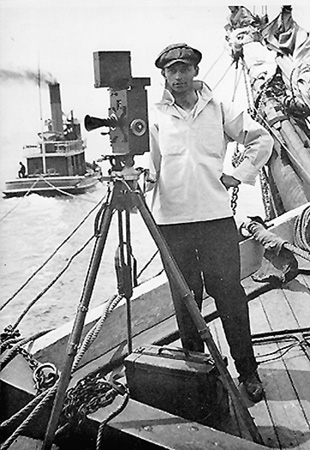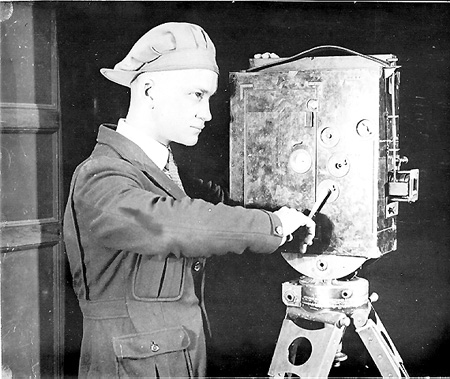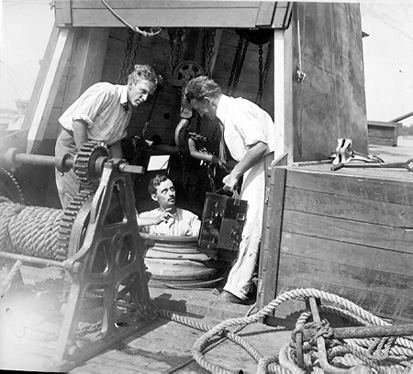 Volume III: Biographies
Volume III: Biographies Volume III: Biographies
Volume III: Biographies


Carl Louis Gregory (L) aboard ship in Nassau, Bahamas in 1914. Carl Louis Gregory estate, courtesy of Ralph Graham, M.D. (P-150)
Carl Louis Gregory (R) turns the crank of a Thanhouser camera, circa 1913-1914. Carl Louis Gregory estate, courtesy of Ralph Graham, M.D. (160)

Photographer Carl Louis Gregory at the top of the undersea tube in the Bahamas, with J.E. Williamson and George M. Williamson (with camera) looking on.
Courtesy of Dominick Bruzzese (X-266-1)
Thanhouser Career Synopsis: Carl Louis Gregory, one of the best known early cinematographers, worked for Thanhouser for several years. A man of many talents, he also directed and wrote scenarios.
Biographical Notes: Carl Louis Gregory, born in Walnut, Kansas in 1882, moved to Ohio with his family at an early age and became interested in photography at the age of 11, when he made his own camera utilizing a cigar box and a lens crafted from a pair of eyeglasses. He attended high school in Cleveland. Soon he was taking pictures for pay, a business which eventually paid his tuition at the Ohio State University, from which he graduated with a bachelor's degree in chemistry in 1904. Later, he studied at the Massachusetts Institute of Technology and Columbia University.
In 1905 he opened photographic studios successively in Monterrey, Mexico; San Antonio, Texas; Colorado Springs, Colorado; and Cleveland, Ohio. The venture was short-lived, and he sold out the following year and joined the United States Department of the Interior as an official photographer. In 1908, he was employed by Burr McIntosh, an wealthy entrepreneur who had fingers in many business pies (films, publishing, stage productions, etc.), for whom he projected slides and motion pictures for lectures, including Our Navy, Our Country, Our Island Possessions, and other novelties popular on the lyceum and Chautauqua circuits. In the spring of 1909, he joined Edison, where he did double duty as a cameraman and director and was responsible for many films while working at the Orange and Bedford Park studios. For Edison he traveled to Cuba to film romances and educational subjects. Among his peers he was well known for trick and double-exposure photography.
With Thanhouser: According to his own account, he joined Thanhouser in 1910, at the time that its second production was being filmed. The title of this film was not stated, but, apparently it was different from the second Thanhouser release (which was St. Elmo). Gregory photographed stills for publicity, including one for the initial Thanhouser release, The Actor's Children (March 15, 1910). He was senior cameraman for Thanhouser for the next several years. During that time he photographed many Thanhouser subjects and supervised the work of other cameramen as well.
His technical knowledge of cinematography was of a high order, and in the trade he was highly esteemed. From time to time his name would appear in print concerning some fine point or detail of motion picture work. For example, in the March 4, 1911 issue of The Moving Picture World, a note from Gregory appeared, correcting an earlier article saying that a lens could be focused as close as one inch distance from it - whereas Gregory said that it cannot be focused any closer than its focal length - a technical point.
A New Film Company: In April 1912, immediately following the sale of the Thanhouser Company to Charles J. Hite and others, Gregory had thoughts of leaving Thanhouser, as reflected in this article in the New Rochelle Evening Standard, April 26, 1912: "The latest thing in motion picture manufacturing concerns is the new Union Picture Film Company, which is the development of the Carey Motion Picture Company located on City Island. The members of the new corporation which has just been incorporated with a capital of $55,000 are Carl L. Gregory; H. Studebaker Henderson, both of New Rochelle; Karl R. Miner, Yonkers; Harry D. Carey [a screen actor and playwright], and Henry B. Walthall.
"Mr. Gregory, who is to be president and general manager, terminates his connection with the Thanhouser Film Company this week with whom he has been for two years as an operator.... The leading man will be Harry B. Walthall and the leading woman will be Fern Foster, both prominent on the motion picture stage. There will be two companies in the field for a while, and Mr. Gregory said yesterday that he will soon have more working. He intends to produce feature pictures of the Northwest. For this purpose the companies have been working all winter on City Island and other islands in the Sound, utilizing the ice in the Sound for frozen North settings.
"The company occupies the peninsula known as Carley's Point, owned by the Carey Estate of which family Mr. Carey is a member. The plant consists of three buildings and the foundation for a glass studio has been started. The company has leased several of the rocky islands and has the privilege of using other islands in the sound. Besides these spots City Island, Pelham Bay Park and considerable of Westchester County are to be used for staging the plays. They are to make educational and advertising subjects also. One of the pictures which is soon to be released is the story of the Woolworth Building from the digging of the excavation for the foundations through the various stages of construction to the opening day." Little ever came of the venture.
Activities in 1913: In May 1913, still with Thanhouser, he returned from a 9,500-mile trip for Majestic, to which studio Charles J. Hite had "loaned" him from Thanhouser in December 1912. His itinerary included Montana, Wyoming, Oregon, California, Arizona, New Mexico, and Colorado. The resulting films were edited to create Life Among the Navajos, released by Majestic on May 27, 1913. Upon his return to New Rochelle he resumed his work as Thanhouser's senior cameraman.
In the summer of 1913, he took a group of Thanhouser players, the "Cape May Company," to New Jersey, where he directed and photographed six films. In view of this double talent, Charles J. Hite named him in the autumn of 1913 to direct the new Princess Department and act as its cameraman. He also wrote a number of scenarios.
Jean Darnell's "Studio Chat - From the Inside" column in the December 1913 issue of The Photoplay Magazine mentioned the Thanhouser cameraman: "The recent heavy rains we have been having made some of the country roads almost impassable in spots. As a rule, the country roads are excellent around New York, but as Carl Gregory, chief cameraman of the Thanhouser Company says, 'There was one bad spot and I hit it.' He was motoring with his sister and Miss Violet Hite to Bridgeport, Connecticut, and they struck the soft spot just out of New Canaan. I can't begin to tell you all Carl said, but the main point is, the motoring party came home on a New Haven train that night. Next morning the Thanhouser truck went up and pulled Greg's car out of the hole. Believe me, these motor trips are often 'aggri-noying.' I know. I have had a few mishaps myself with my car, and wasn't so fortunate as Gregory to be near a railroad."
More Successes: In February 1914 Carl Louis Gregory was transferred from the directorship of Princess to become assistant director to Carroll Fleming in the making of Thanhouser "Big Productions." Gregory was cameraman for the Williamson brothers in their pioneering submarine photography in the West Indies, 1914 and later, and achieved wide recognition for his undersea work. Excerpts from this footage were used to create films exhibited in the summer and autumn of that year, including at the star-crossed New York City attraction, the Broadway Rose Gardens. In August and September 1914 he led a party of Thanhouser players to Yellowstone National Park and other places in the West. On the trip he was scriptwriter, director, and cameraman for several films.
The New Rochelle Pioneer, May 22, 1915, mentioned the cameraman's successes: "Carl Louis Gregory, who was recently honored by the Royal Photographic Society of Great Britain, with honorary membership, is the only American photographer so far as is known to be thus honored, and by letter from the secretary it is intimated that Mr. Gregory may be elected to fellowship. The Moving Picture World, after trying 15 months to secure Mr. Gregory as its camera editor, finally succeeded, and Carl will soon have a department in the international trade publication. This is an honor, indeed, yet Carl still wears the same size hat."
The New Rochelle Pioneer, July 10, 1915, told of his exodus from Thanhouser: "Carl Gregory, star cameraman, has resigned from the local studio to accept a position with the Metro Film Company of California, at a large increase in salary. This is the same company that Peggy Snow is now connected with. Mr. Gregory will leave his present position in this city next Saturday. Mr. Gregory lives at 19 Rhodes Street with his two sisters, and all are popular with the younger set. Mr. Gregory has been connected with the Thanhouser forces for the past five and one half years. During his stay he has at different times been director and cameraman at the same time. Mr. Gregory is an expert on night field work as well as submarine photography. The late experiments in night photography in the open air were in charge of Carl Gregory, who is cameraman for John Harvey, the director who is now with the Lubin forces."
The 1914 and 1915 editions of the New Rochelle city directory gave Carl Louis Gregory's home address as 19 Rhodes Street, New Rochelle, the address also of his two younger sisters, Fannie and Anne, who acted in Thanhouser films. At one time Violet Hite lived at the same address as well. By 1917 his home address was Pembroke Street and his business address was 1007 Times Building, New York City. In 1922, Carl's home address was 76 Echo Avenue, the same address used by his sisters. In 1933 he was located at the same address.
Later Years: During the 1914-1916 years Gregory was a popular lecturer on the subject of motion picture photography. Among his audiences were the organizations to which he belonged, including the American Chemical Society, the New York Camera Club, the Screen Club, and the Cinema Club. In 1917 he worked in Florida for Technicolor.
An important event in Gregory's life was the subject of an article in The Moving Picture World, February 10, 1917: "Carl Louis Gregory...was married to Miss Myrta Belle Strong in Jacksonville, Florida, on Saturday, January 20. The ceremony, which was witnessed by scores of the couple's friends, took place at noon in the sunshine parlor of the Hotel Burbridge. The bride, who arrived from her home in Cleveland a few hours before the ceremony, was given away by C.A. ('Doc') Willat, manager of production for the Technicolor Company. The marriage of Mr. Gregory and Miss Strong brings to a happy climax the romance of 20 years' standing. The beginning of the romance dates back to the time that both bride and bridegroom were attending school in Cleveland."
In 1918 he was a cameraman for the Fox film, Queen of the Sea, featuring swimming champion and physical culture advocate Annette Kellermann. During the World War, Gregory was the chief instructor in cinematography at the Signal Corps School of Photography at Columbia University, New York City, where more than 700 motion picture and still photographers were trained in a short period of time. He wrote a popular reference book, Motion Picture Photography. After the war, Gregory was an instructor in photographic technique at Columbia University. Later he was named as Dean of Photography at the New York Institute of Photography. He was director and cameraman for the 1920 Fidelity release of Love's Flame. He was active in the field for many years, and in the late 1920s was considered to be the dean of his profession.
At one time he was chief of production for the Orient and India Pictures Corporation, affiliated with the Frawley-Blood Motion Picture Company of New York City, which took a company of 15 American and British actors to such far-flung places as Hawaii, Japan, China, the Philippine Islands, Malaya, Burma, the South Seas, and India. On the island of Hilo, Hawaii the film, The 13th Girl, was photographed. During the trip Gregory exposed 20,000 feet of film. Later he became a consulting engineer with the Kislyn Color Corporation, a firm which sought to exploit a color motion picture process invented by Louis Berthon. In the early 1940s Carl Louis Gregory did work for the National Archives and while there was the first person to attempt restoration of paper prints of early motion pictures.
Carl Louis Gregory died of arteriosclerosis after a year-long illness, at his home in Van Nuys, California on March 11, 1951. Services were held at Wee Kirk o' the Heather, Forest Lawn. He was survived by his widow, Marie Garrison Gregory, and five sisters. Certain stills and other items from his estate were acquired by film historian Jonathan Miller, who sold them to Ralph E. Graham, M.D., who, in turn, loaned numerous photographs for inclusion in the present volume.
Thanhouser Filmography:
1911: The Lady From the Sea (12-12-1911)
1912: The Guilty Baby (2-27-1912), The Poacher (3-15-1912), Nicholas Nickleby (3-19-1912), My Baby's Voice (3-29-1912), The Star of the Side Show (4-2-1912), The Baby Bride (4-16-1912), When Mandy Came to Town (4-26-1912), The Cry of the Children (4-30-1912), The Capture of New York (9-1-1912)
1913: Moths (Mutual 9-1913), Louie, the Life Saver (10-7-1913), A Deep Sea Liar (10-12-1913), Beauty in the Seashell (10-19-1913), The Mystery of the Haunted Hotel (10-21-1913), Lobster Salad and Milk (Princess 10-21-1913), Algy's Awful Auto (Princess 10-31-1913), Friday, the Thirteenth (Princess 11-7-1913), The Campaign Manageress (11-11-1913), Bread Upon the Waters (Princess 11-14-1913), A Shot Gun Cupid (Princess 11-21-1913), Her Right to Happiness (Princess 11-28-1913), The Legend of Provence (12-1-1913), The Little Church Around the Corner (Princess 12-5-1913), His Imaginary Family (12-12-1913), The Law of Humanity (12-19-1913), Cupid's Lieutenant (Princess 12-26-1913)
1914: A Rural Free Delivery Romance (Princess 1-2-1914), A Circumstantial Nurse (Princess 1-9-1914), When the Cat Came Back (Princess 1-16-1914), The Vacant Chair (Princess 1-23-1914), The Purse and the Girl (Princess 1-30-1914), Where Paths Diverge (Princess 2-6-1914), Percy's First Holiday (2-8-1914), The Tangled Cat (Princess 2-13-1914), All's Well That Ends Well (Princess 2-20-1914), The Hold-Up (Princess 2-27-1914), Her Way (Princess 3-6-1914), A Seminary Consumed by Flames (3-4-1914), One Hour of Youth (4-12-1914), The Strike (4-21-1914), From the Flames (4-28-1914), The Terrors of the Deep (Submarine Film Corporation-Thanhouser 7-22-1914), A Bahaman Pineapple Plantation (Princess 7-24-1914), The Cavalry at Fort Meyer, Virginia (Princess 7-24-1914), From Wash to Washington (7-26-1914), Thirty Thousand Leagues Under the Sea (Submarine Film Corporation-Thanhouser 9-14-1914), The Wild, Wooly West (Princess 11-27-1914), A Denver Romance (11-29-1914), When East Meets West (12-13-1914), The Barrier of Flames (12-15-1914)
1915: A Yellowstone Honeymoon (1-17-1915), Yellowstone Park Scenic, No. 1 through 6 (prepared circa 1-18-1915), Their One Love (5-2-1915), Fairy Fern Seed (5-25-1915), The Patriot and the Spy (6-7-1915), The Price of Her Silence (9-30-1915)
# # #
Copyright © 1995 Q. David Bowers. All Rights Reserved.